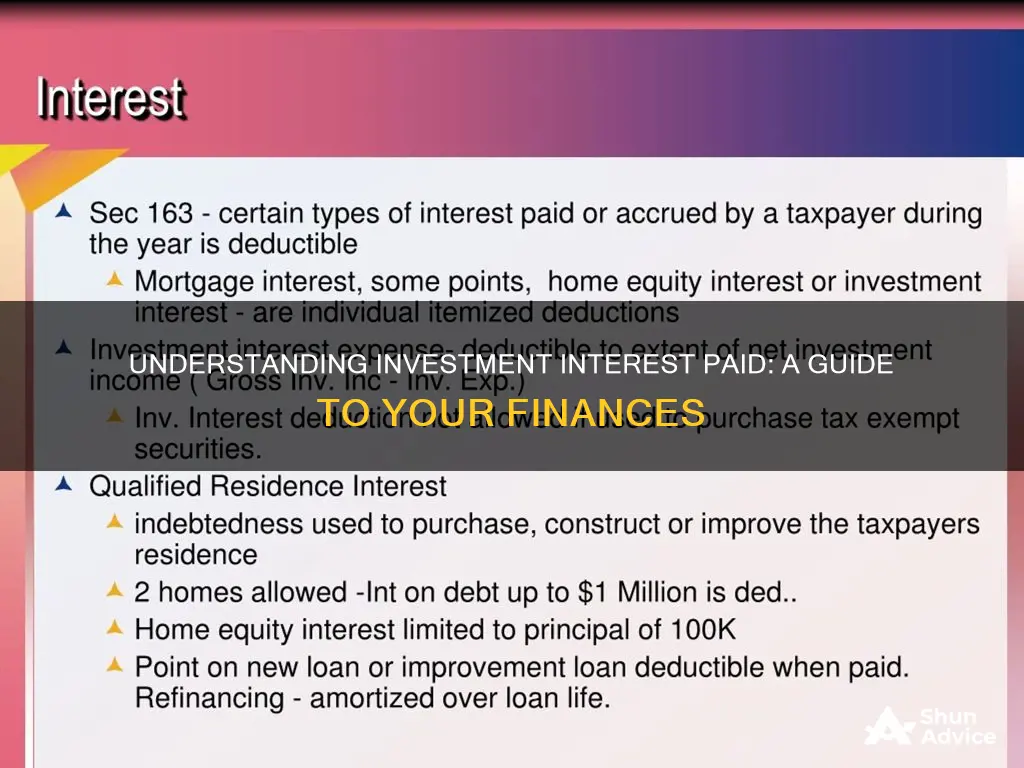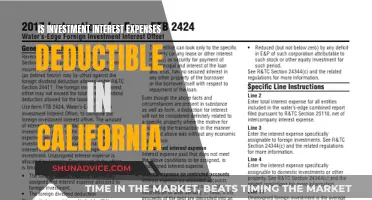
Investment interest paid is the amount of interest charged on a loan related to an investment. This could include margin loan interest or interest on an investment property. Investment interest expenses are tax-deductible in some circumstances, but not when used for passive ventures, such as investing in a business that the taxpayer owns but does not actively manage. For example, if you borrow money to buy a house to rent out, the interest isn't deductible as investment interest.
| Characteristics | Values |
|---|---|
| Definition | Any amount of interest that is paid on loan proceeds used to purchase investments or securities |
| Example | A margin loan taken out with a brokerage to purchase stock |
| Tax | Deductible in certain circumstances |
| Tax | Not deductible when used for passive ventures, such as investing in a business that the taxpayer owns but does not actively manage |
| Tax | Not deductible if the loan was put toward acquiring a rental property |
What You'll Learn

Investment interest expenses are deductible in certain circumstances
If an investment is made for both personal and business gain, income and expenses must be allocated proportionally. Investment interest expenses are tax-deductible in some circumstances, but not when used for passive ventures, such as investing in a business that the taxpayer owns but does not actively manage. For example, if a taxpayer took out a loan to invest in a business they own but does not take an active, material role in managing that business, the interest on that loan would not qualify as an investment interest expense. Similarly, if the loan was put toward acquiring a rental property, this deductible could not be claimed against the interest paid on that loan.
Investment interest expenses are deductible up to the amount of investment income received, such as dividends and interest. The deduction on investment interest also cannot be larger than the investment income that was earned that year. It is possible for such excess to be carried forward into the next year's tax filing. To claim the deduction for investment interest expenses, you must itemize your deductions. Investment interest goes on Schedule A, under "Interest You Paid." You may also have to file Form 4952, which provides details about your deduction.
Interest Rates: Impacting Investment Strategies and Returns
You may want to see also

Investment interest expenses include margin interest
Investment interest expenses are any amount of interest that is paid on loan proceeds used to purchase investments or securities. This includes margin interest used to leverage securities in a brokerage account and interest on a loan used to buy property held for investment.
Margin interest is the interest charged on a margin loan, which is a loan taken out with a brokerage to purchase stock. This type of loan allows investors to borrow money from a brokerage firm to buy securities, with the understanding that the securities themselves will act as collateral for the loan. Margin interest is a common example of an investment interest expense.
If an investment is held for both business and personal gain, any income received must be allocated proportionally between them. In this case, the investment interest expense is reported on Schedule A of 1040.
It is important to note that the deduction on investment interest cannot be larger than the investment income earned that year. Additionally, the investment cannot be made towards a passive venture, such as investing in a business that the taxpayer owns but does not actively manage. Rental activity is generally considered a passive activity, so if you borrow money to buy a rental property, the interest is not deductible as investment interest. However, the interest can be used as an expense item for the operation of the rental property on Schedule E.
The Magic of Compound Interest for Long-Term Investments
You may want to see also

Investment interest expenses are not deductible for passive ventures
Investment interest expenses are any amount of interest paid on loan proceeds used to purchase investments or securities. They include margin interest used to leverage securities in a brokerage account and interest on a loan used to buy property held for investment.
Investment interest expenses are deductible in certain circumstances. They are tax-deductible when they are related to an investment, such as margin loan interest or interest on an investment property. However, they are not deductible when used for passive ventures, such as investing in a business that the taxpayer owns but does not actively manage. For example, if a taxpayer took out a loan to invest in a business they own but does not take an active, material role in managing that business, the interest on that loan would not qualify as an investment interest expense. Similarly, if the loan was put toward acquiring a rental property, this deductible could not be claimed against the interest paid on that loan.
If an investment is held for both business and personal gain, any income received must be allocated proportionally between them. Personal investment interest expense is reported on Schedule A of 1040. A common example of this type of expense is the application of proceeds from a margin loan, taken out with a brokerage, in order to purchase stock.
The deduction on investment interest also cannot be larger than the investment income that was earned that year. It is possible for such excess to be carried forward into the next year's tax filing.
Investment Interest Expense: What Can Be Deducted?
You may want to see also

Rental activity counts as passive activity
Investment interest expense is any amount of interest that is paid on loan proceeds used to purchase investments or securities. This includes margin interest used to leverage securities in a brokerage account and interest on a loan used to buy property held for investment.
Rental activity generally counts as passive activity. Therefore, if you borrow money to buy a house to rent out, the interest isn't deductible as investment interest. However, you can use the interest as an expense item for the operation of the rental property on Schedule E. You must itemise your deductions, and investment interest goes on Schedule A, under 'Interest You Paid'. You may also have to file Form 4952, which provides details about your deduction.
You don't have to file Form 4952 if you meet the following three conditions: interest is the only investment expense you're deducting; you're not carrying forward any disallowed interest from the previous year; and your investment interest doesn't exceed your investment income from interest and ordinary dividends.
If an investment is held for both business and personal gain, then any income received must be allocated proportionally between them. Personal investment interest expense is reported on Schedule A of 1040.
Invest Wisely, Live Comfortably Off Your Interest
You may want to see also

Investment interest expenses are reported on Schedule A of 1040
Investment interest expenses are any amount of interest paid on loan proceeds used to purchase investments or securities. This includes margin interest used to leverage securities in a brokerage account and interest on a loan used to buy property held for investment.
If an investment is held for both business and personal gain, then any income received must be allocated proportionally between them. Personal investment interest expenses are reported on Schedule A of 1040. This includes property that produces a gain or a loss, as well as interest, dividends, and royalties that were not derived from the ordinary course of trade or business.
It is important to note that the deduction on investment interest cannot be larger than the investment income earned that year. Additionally, the investment cannot be made towards a passive venture, such as investing in a business that the taxpayer owns but does not actively manage. In the case of rental properties, the interest on the loan cannot be claimed as an investment interest expense.
To claim the deduction for investment interest expenses, taxpayers must itemize their deductions. Investment interest goes on Schedule A, under "Interest You Paid." In some cases, Form 4952 may also need to be filed to provide additional details about the deduction. However, this form is not required if certain conditions are met, such as interest being the only investment expense deducted and the investment interest not exceeding the investment income.
Investments: Compounding Interest Options for Your Money
You may want to see also
Frequently asked questions
Investment interest paid is the interest charged for a loan related to an investment, such as margin loan interest or interest on an investment property.
A common example of investment interest paid is the application of proceeds from a margin loan, taken out with a brokerage, in order to purchase stock.
Investment interest expenses are tax-deductible in certain circumstances. For example, if you borrowed money to buy a house to rent out, the interest isn't deductible as investment interest. However, you could use the interest as an expense item for the operation of the rental property.
To claim the deduction for investment interest expenses, you must itemize your deductions. Investment interest goes on Schedule A, under "Interest You Paid." You may also have to file Form 4952, which provides details about your deduction.







